Comparisons between the MiG-29 (initially allocated the internal OKB designation 9-12) and the American Lockheed (General Dynamics) F-16 are perhaps inevitable, since both fulfil the same broad tactical fighter role, both are extremely agile high-performance aircraft optimised for dogfighting, both have been widely exported, and both were designed to meet requirements for a 'lightweight fighter'.
The MiG-29 which is recognised today was derived from a study for a heavier fighter (also designated MiG-29) designed to counter the F-15 under the Perspektivnyi Frontovoi Istrebeitel ('prospective frontal fighter') competition. The Mikoyan OKB proposed following the US example, with both heavy and light fighters complementing each other to meet the requirement. Its arguments were accepted and the requirement was redrafted to cover two quite separate aircraft. The new Soviet air forces' requirement for a Logkii Frontovoi Istrebityel ('lightweight front-line fighter') was issued in 1972, and Mikoyan successfully submitted a smaller version of the original design, the MiG-29D (Dubler - double), while Sukhoi submitted the T-10 proposal to meet the Tyazholyi Froniovoi Istrebityel requirement.
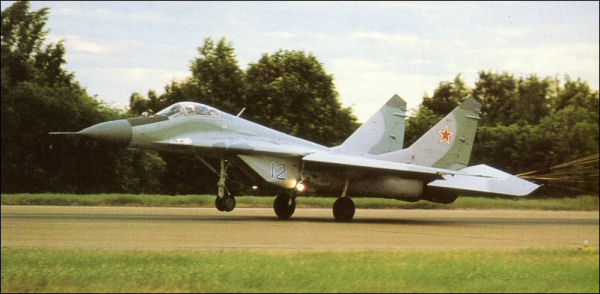 A MiG-29 lands
at Rissala during an exchange visit to Finland during 1986. The aircraft
represents the initial definitive production standard. It has no ventral
fins, and has a narrow-chord rudders and an undernose 'Swift Rod' ILS-antenna,
but does have the fin leading-edge flare dispensers.
A MiG-29 lands
at Rissala during an exchange visit to Finland during 1986. The aircraft
represents the initial definitive production standard. It has no ventral
fins, and has a narrow-chord rudders and an undernose 'Swift Rod' ILS-antenna,
but does have the fin leading-edge flare dispensers.
The new Soviet air force LFI requirement detailed a replacement for Frontal Aviation's MiG-21s and MiG-23s, Su-7s and Su-17s. The new fighter was to be capable of destroying enemy fighters in air combat, destroying enemy bombers and reconnaissance aircraft, and escorting friendly bombers and attack aircraft. The aircraft would also have an important secondary ground attack role. A production order was placed at the same time as the Technical Assignment was issued, meaning that the MiG-29 never received an in-house I- ('Ye-') designation.
The increasing importance of low-level penetration by attack aircraft made look-down/shoot-down capability vital, while the growing importance of ECM made a capacity for independent action similarly important. The aircraft was from the start designed to be able to beat the new generation of US fighters (the F-14, F-15, YF-16 and YF-17) in air combat, and to restore the tarnished reputation of Soviet fighters incurred by heavy losses in the Middle East. Finally, a measure of rough-field/dispersed site capability was felt to be essential. Detailed design work began in 1974, the year that the F-15 entered service and that the YF-16 first flew.
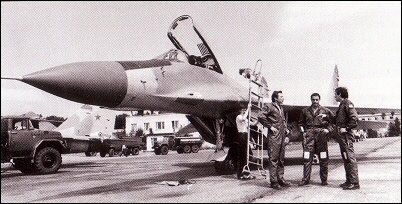 The very first
production series MiG-29s had an unusual debris deflector ahead of the nosewheels.
Some are still used for trials, like this aircraft, which has a MiG-29M-type
embedded radio compass antenna in the canopy.
The very first
production series MiG-29s had an unusual debris deflector ahead of the nosewheels.
Some are still used for trials, like this aircraft, which has a MiG-29M-type
embedded radio compass antenna in the canopy.
While the MiG-29's configuration is superficially similar to those of the F-14, F-15, YF-17 and Su-27, it is different in many important ways, although common problems make some common solutions inevitable. Starting with a blended high-lift, low-drag wing and forebody, Mikoyan added twin canted fins, widely flared wing leading-edge root extensions and widely spaced twin engines with carefully tailored intakes to maximise high angle-of-attack capability. The original MiG-29 had been broadly similar, but with a faired-in MiG-25-type cockpit and with MiG-25-type engine intakes on each side of a conventional fuselage, with no inter-engine tunnel.
While some have criticised the MiG-29 for its supposedly crude finish in places, there can be no doubt that its aerodynamic design is extremely advanced, giving unmatched low-speed and high-Alpha handling characteristics, which can be invaluable in a 'close-in' engagement. The electro-mechanical flight control system has no 'hard limits', allowing the pilot briefly to override pitch and g limiters when tactically necessary, by deliberately pulling through a stick stop to enter that area of the flight envelope where departure becomes progressively more likely. Ample aerodynamic warning is given before the aircraft departs. When it does, the MiG-29 is reluctant to spin and recovers when pro-spin controls are released. Sophisticated aileron/rudder interconnects gradually phase out aileron at increasing angles of attack.
Flying controls are mainly conventional, and are hydraulically controlled. Computer-controlled full-span manoeuvre flaps occupy the wing leading edge, with plain flaps inboard and ailerons outboard on the trailing edge. The horizontal tail surfaces are all-moving.
To allow the aircraft to operate from primitive forward airfields, the low-mounted intakes are fitted with large doors that close on start-up, open only after the aircraft has rotated on take-off, and close again when the mainwheels touch on landing. These prevent the ingestion of mud, snow or other debris. While the main intakes are closed, air is drawn in through spring-loaded louvres in the top of the wingroots. Flight is possible at speeds of up to 800 km/h (432 kt; 500 mph) with the main intakes closed.
The MiG-29 broke much new ground for Mikoyan, with advanced aerodynamics, avionics, systems and even materials. The new aircraft made extensive use of advanced, lightweight aluminium-lithium alloys, which allowed fewer fasteners and bolts to be used, with savings in weight and production complexity. The operational life of the MiG-29 airframe, however, is believed to be significantly shorter than equivalent Western aircraft types.
The MiG-29 is powered by a pair of Sargisov (Leningrad/Klimov, formerly Isotov). RD-33 afterburning turbofans. These produce considerably more augmented thrust than equivalent Western aircraft types, but slightly less in dry power. This can make the aircraft more reliant on using afterburner in some circumstances, increasing fuel consumption. The latest versions of the engine have a full-authority digital engine-coontrol system, and a sophisticated stall prevention/relight system. The engine is understood to have a four-stage fan (with fixed stator vanes) and a nine-stage high-pressure compressor (with variable stators on the first three stages). The time between overhaul is reportedly 350 hours.
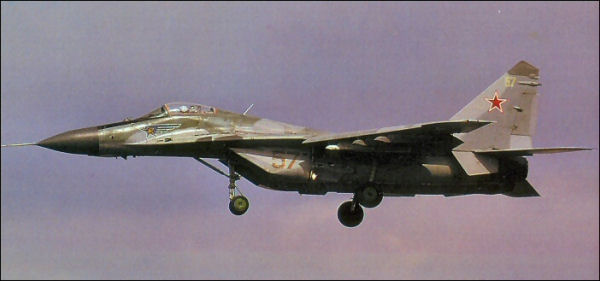 The earliest
production MiG-29s had ventral fins below the vertical fins and tailplanes,
and lacked the fin leading-edge extension chaff/flare disepensers fitted
to later MiG-29s. These early aircraft were retrofitted with broad-chord
rudders and pitot-mounted vortex generators after entry service.
The earliest
production MiG-29s had ventral fins below the vertical fins and tailplanes,
and lacked the fin leading-edge extension chaff/flare disepensers fitted
to later MiG-29s. These early aircraft were retrofitted with broad-chord
rudders and pitot-mounted vortex generators after entry service.
Eleven prototypes (9-01 to 9-11) were built, the first flying initially on 6 October 1977. Two of them were lost in engine related accidents. Spotted by a US satellite at Ramenskoye in November 1977, the aircraft was allocated the provisional reporting name 'Ram-L'. The prototypes were followed by eight pre-production aircraft (9-12 to 9-19). Frontal Aviation evaluation commenced in 1983, and the aircraft began to enter service soon afterwards, initially with the Kubinka and Ros regiments. Early reliability problems were soon solved, and MTBF figures rose from 2.3 hours to 5.7 hours by 1988, while mission-capable rates rose from 65 per cent to 90 per cent over the same period.
The 'bald' MiG-29 designation covers most of the single-seat fighters delivered so far, although a host of improvements have been incorporated, some of them giving the aircraft involved a distinctive appearance and which might have been expected to lead to allocation of a new service designation (see 'Fulcrum-C' entry). Small ventral fins, initially fitted to the prototype after its first flight, were deleted after a small batch of production aircraft (probably about 100) had been completed, at the same time as overwing chaff/flare dispensers were fitted in extensions to the tailfin leading edges. Extended-chord rudders and pitot-mounted vortex generators were adopted in the late 1980s, and were retrofitted to all service aircraft (including some of the earliest standard ventral-finned machines which remained in use even in 1994).
In the fighter role, the MiG-29 carries six underwing missiles, with two BVR R-27R/ AKU-470 AA-10 'Alamo-As' inboard (usually both semi-active radar homing, but sometimes with one IR-homing 'Alamo-B') and four R-60/AA-8 'Aphid' or AA-11 'Archer' short-range IR-homing AAMs outboard. These are backed up by an internal lightweight GSh-301 single-barrelled 30-mm cannon, which replaced a twin-barrelled weapon on the first prototype.
The fire-control system is a sophisticated sensor, with data gathered by the aircraft's sensors being datalinked to a ground station or AWACS aircraft. The radar is extremely powerful and can easily overwhelm the pilot with information, and filtering and software techniques are inadequate for on-board threat prioritisation. The need to keep contact with an external agency limits the MiG pilot's capacity for independent action, and imposes a degree of inflexibility. ('Freelance' operations and independent search are, however, seen as desirable, and are stressed much more in current doctrine.)
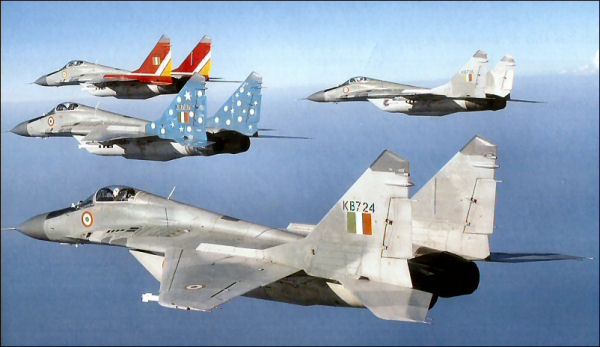 This quartet
of Indian MiG-29s is drawn from Nos 28 and 47 Squadrons. Coloured tail units
are used to differentiate friend from foe during non-dissimilar air combat
training. Each aircraft carries an R-60 AA-8 'Aphid' acquisition round.
This quartet
of Indian MiG-29s is drawn from Nos 28 and 47 Squadrons. Coloured tail units
are used to differentiate friend from foe during non-dissimilar air combat
training. Each aircraft carries an R-60 AA-8 'Aphid' acquisition round.
The MiG-29 has two sensors for target acquisition. The first is the N-019
pulse-Doppler radar, which has previously been misidentified as the HO-93,
the HO-193 and the NO-193, confusion arising because the Cyrillic letter 'H'
is in fact an English 'N', and the '3' is an 'E' (for export), and because
on a Farnborough demonstrator a hyphen was misplaced. The radar is known to
NATO as 'Slot Back'. A measure of passive target acquisition capability is
afforded by the IRST, which has a collimated laser rangefinder. This can be
used to detect, track and engage a target while leaving the radar in a passive
(non-emitting) mode, ready to be 'turned on' if contact is lost (if the target
goes into cloud, for instance) or to fire a
semi-active radar-homing missile. All the while, the target aircraft's RWR
will not detect the MiG-29's unwelcome attentions.
For close-in engagements, a helmet-mounted sight (which works by sensing the pilot's head position) can be used to cue IR-homing missiles onto an off-boresight target. This is extremely useful in conjunction with the very agile R-73 (AA-11 'Archer') AAM, although firing at an angle well off the nose dramatically reduces missile range.
Primarily designed for fighter/air superiority duties, the MiG-29 nonetheless has an important secondary ground attack role. It is therefore able to carry a variety of bombs, rockets and missiles on the inboard and central underwing pylons, although the outboard pylons are believed to be reserved for the carriage of R-60 (AA-8 'Aphid') or R-73 IR-homing AAMs. Many Frontal Aviation MiG-29 regiments are believed to incorporate a nuclear strike squadron, whose aircraft can carry a single 30-kT RN-40 nuclear bomb on the port inboard pylon. A handful of MiG-29 regiments have even been assigned a primary air-to-ground role, including at least one of the units now under Ukrainian command. For ferrying, fuel tanks can be carried under the inboard underwing pylons, augmenting the tank carriedon the centreline, which is stressed to 9 g.
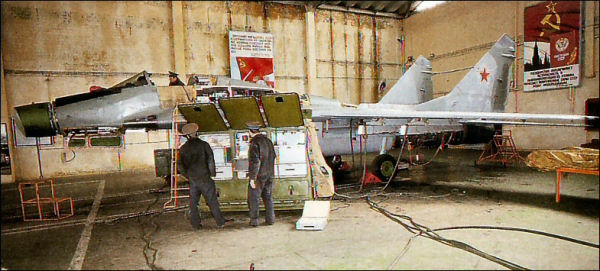 A Soviet air
force MiG-29 undergoes servicing; with its radome removed, the unusual twist-cassegrain
antenna of the 'Fulcrum's' N-019 'Slot Back' radar is revealed. The MiG-29
is remarkably maintainable but operators have to suffer a short time-between-overhauls,
plus poor after-sales support and spares availability.
A Soviet air
force MiG-29 undergoes servicing; with its radome removed, the unusual twist-cassegrain
antenna of the 'Fulcrum's' N-019 'Slot Back' radar is revealed. The MiG-29
is remarkably maintainable but operators have to suffer a short time-between-overhauls,
plus poor after-sales support and spares availability.
About 450 'Fulcrums' are estimated to be in service with the VVS (more than 300 were in service with the Soviet air forces in East Germany alone during 1990), with 50 more in AV-MF service. Byelorussia, Kazakhstan, Moldova and Ukraine account for some 350 more. An estimated 380 have been delivered to export customers. Total production, including UBs and 'Fulcrum-Cs', probably stands at 1,250-1,350.
The Moscow Aircraft Production Organisation is presently offering a programme of modifications to MiG-29 operators that is aimed at improving the aicraft's combat potentinal. This programme would bring any 'Fulcrum-A' to virtual MiG-29S or MiG-29SE standard. The modifications include making the inboard underwing pylons compatible with a pair of 1150-litre (304-US gal) fuel tanks (this modification has already been applied to some 40 per cent of Russian MiG-29s, including the factory demonstrators and most of those aircraft based in Germany and Hungary). Other improvements include the provision of compatibility with the new R-77 (AAM-AE) active radar homing missile and simultaneous two-target engagment capability. The flight control system is modified to allow the aircraft to reach higher angle of attack (30°+), and Western navaids can be installed. A new radio with the standard international emergency frequency of 243 Mhz is also provided. Finally, the inboard underwing pylons are restressed for the carriage of up to four 500-kg (1,102-lb) bombs each, in tandem side-by-side pairs.
MAPO hopes to offer a retrofitted in-flight-refuelling probe, a ground mapping radar mode and compatibility with anti-radar, TV- and laser-guided ASMs in 1995.
 A
Czech MiG-29 reefs into a 'burner' climb. The Czechoslovakian and East German
air forces had their MiG-29s delivered in brown and green camouflage, applied
to only a handful of Soviet MiG-29s. The Czech Republic is selling the MiG-29s
it inheritated on the division of Czechoslovakia.
A
Czech MiG-29 reefs into a 'burner' climb. The Czechoslovakian and East German
air forces had their MiG-29s delivered in brown and green camouflage, applied
to only a handful of Soviet MiG-29s. The Czech Republic is selling the MiG-29s
it inheritated on the division of Czechoslovakia.
WEAPON OPTIONS
In service, the MiG-29 is used primarily in the air-to-air fighter role. Its primary BVR armament is the R-27 (AA-10 'Alamo'), two of which may be carried on the inboard underwing pylons. The 'Fulcrum' usually carries the short-burn semi-active radar-homing R-27R ('Alamo-A') sometimes with one example of the similar IR-homing R-27T ('Alamo-B'), or sometimes as a pair of semi-active radar-homing missiles. The 'Fulcrum' is believed to be compatible with later long-burn versions of the R-27, but there have not been noted in released photographs and may have been given to long-range PVO interceptor Su-27s as a priority.
Early reports that the MiG-29 could carry the AA-9 'Amos' are completely unfounded. When it first entered service, the MiG-29 usually carried R-60 (AA-8 'Aphid') short-range IR-homing missiles on the centre and outboard underwing pylons, but these have largely been replaced by the more capable R-73 RM2D (AA-11 'Archer'), a short-range IR-homing dogfight missile of exceptional agility, which has been rated by some experts as being superior to any Western equivalent.
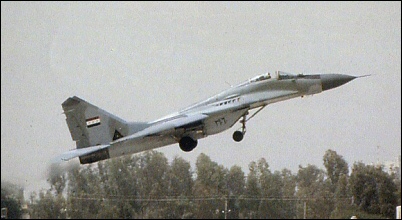
An Iraqi MiG-29 takes off before Desert Storm. Iraqi 'Fulcrum' strength was severly depleted by the Gulf War, with losses in air-to-air combat and on the ground to coalition airfield attacks, together with the non-return of aircraft which fled to Iran for sanctuary.
Some MiG-29s, especially those supplied to Warsaw Pact export customers, have been seen with 'cheap' AA-8s outboard, a pair of AA-11s on the centre pylons and AA-10s inboard. Some foreign customers (Cuba, Iran, Iraq and Syria, for example) may not have received AA-11s at all. In the future, MiG-29s will probably receive the active-homing R-77 ('AMRAAMski'), if it enters service, but this will require some modifications.
In the fighter-bomber role, MiG-29s have been seen carrying the B-8W 20-round 80-mm rocket pod and the older UV-32-57 32-round 57-mm rocket pod on inboard and/or centre underwing pylons. The S-24 240-mm rocket can be carried singly on the same pylons. The MiG-29 is believed to be compatible with the B-13 five-round 130-mm rocket pod, although use of this pod has not yet been confirmed. 'Fulcrum' ground attack weapons which can be confirmed include FAB-250ShN and -500ShN, FAB-250M-46 and -500M-46 and FAB-250M-62 and -500M-62 general-purpose bombs, and a range of specialised weapons. These include cluster bombs like the RBK-250 and -500, containing AO-2.5 RTM fragmentation munitions, BETAB concrete penetratiors, PTAB-1M anti-armour minitions, or SPBE anti-armour bomblets. The reusable KMGU-2 sub-munition dispenser carries AO-2.5 fragmentation bombs, which are dispensed through the container's rotary doors downwards, or to either side, depending on how the KMGU-2 container is mounted. BETAB-250 or -500 concrete-piercing bombs, BRAB-200, -220 and -500 armour-piercing bombs, FOZAB-500 incendiary bombs, ODAB-500 FAE bombs, and the deadly OFZAB-500 fragmentation/incendiary bomb are also compatible with the MiG-29.
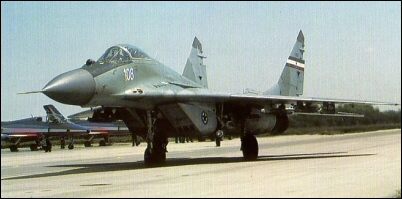 This
MiG-29 wears old-style Yugoslav markings, which have been replaced on some
aircraft by a horizontally banded roundel on the intake (blue, white and red,
descending) and a similar fin flash on the tail.
This
MiG-29 wears old-style Yugoslav markings, which have been replaced on some
aircraft by a horizontally banded roundel on the intake (blue, white and red,
descending) and a similar fin flash on the tail.
SPECIFICATION
Mikoyan MiG-29 'Fulcrum-A'
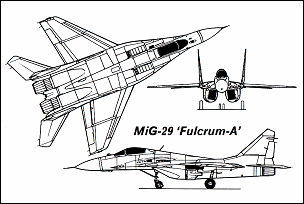 Wing: span 11.36m (37 ft 3.25 in); aspect ratio 3.4; wing area 38.00 m2 (409.04
sq ft)
Wing: span 11.36m (37 ft 3.25 in); aspect ratio 3.4; wing area 38.00 m2 (409.04
sq ft)
Fuselage and tail: length 17.32 m (56 ft 9.85 in) including probe; height 4.73
m (15 ft 6.2 in); tailplane span 7.78 m (25 ft 6.25 in); wheel track 3.10 m
(10 ft 2 in); wheel base 3.67 m (12 ft 0.5 in)
Powerplant: two Klimov/Leningrad (Isotov/Sarkisov) RD-33 augmented turbofans
each rated at 49.42 kN (11,111 lb st) dry and 81.39 kN (18,298 lb st) with
afterburning
Weights: operating empty 10900 kg (24, 030 lb); normal take-off 15240 kg (33,
598 lb); maximum take-off 18500 kg (40, 785 lb)
Fuel and load: internal fuel 3200 kg (7,055 lb) 4300-4365 litres (1,136-1,153
US gal); external fuel one 1500-1520 litre (396-402 US gal) centreline tank
and (on some Soviet aicraft) two 1150-litre (303 US gal) underwing ferry tanks;
maximum ordnance 3000 kg (6,614 lb)
Speed: maximum level speed 'clean' at 11000 m (36,090 ft) 2445 km/h (1,319
kt; 1,519 mph) or at sea level 1500 km/h (810kt; 932 mph)
Range: ferry range 2100 km (1,134 nm; 1,305 miles) with three
tanks; range 1500 km (810 nm; 932 miles) with internal fuel
Performance: maximum rate of climb at sea level 19800 m (64,961
ft) per minute; service ceiling 17000 m (55,775 ft); take-off run 250 m (820
ft) at normal take-off weight; landing run 600 m (1,969 ft) at normal landing
weight with brake-chute
g limits: +9 below Mach 0.85 and +7 above Mach 0.85
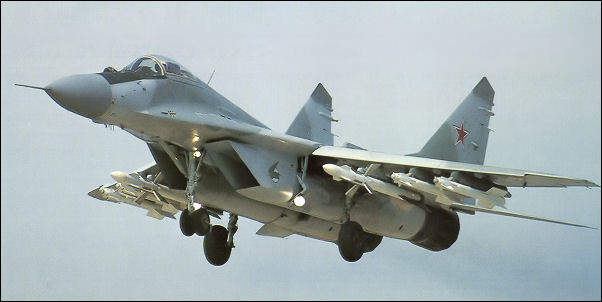 This
approach-configured MiG-29 is laden with R-27R AA-10 'Alamo' and R-73 AA-11
'Archers' underwing.
This
approach-configured MiG-29 is laden with R-27R AA-10 'Alamo' and R-73 AA-11
'Archers' underwing.
